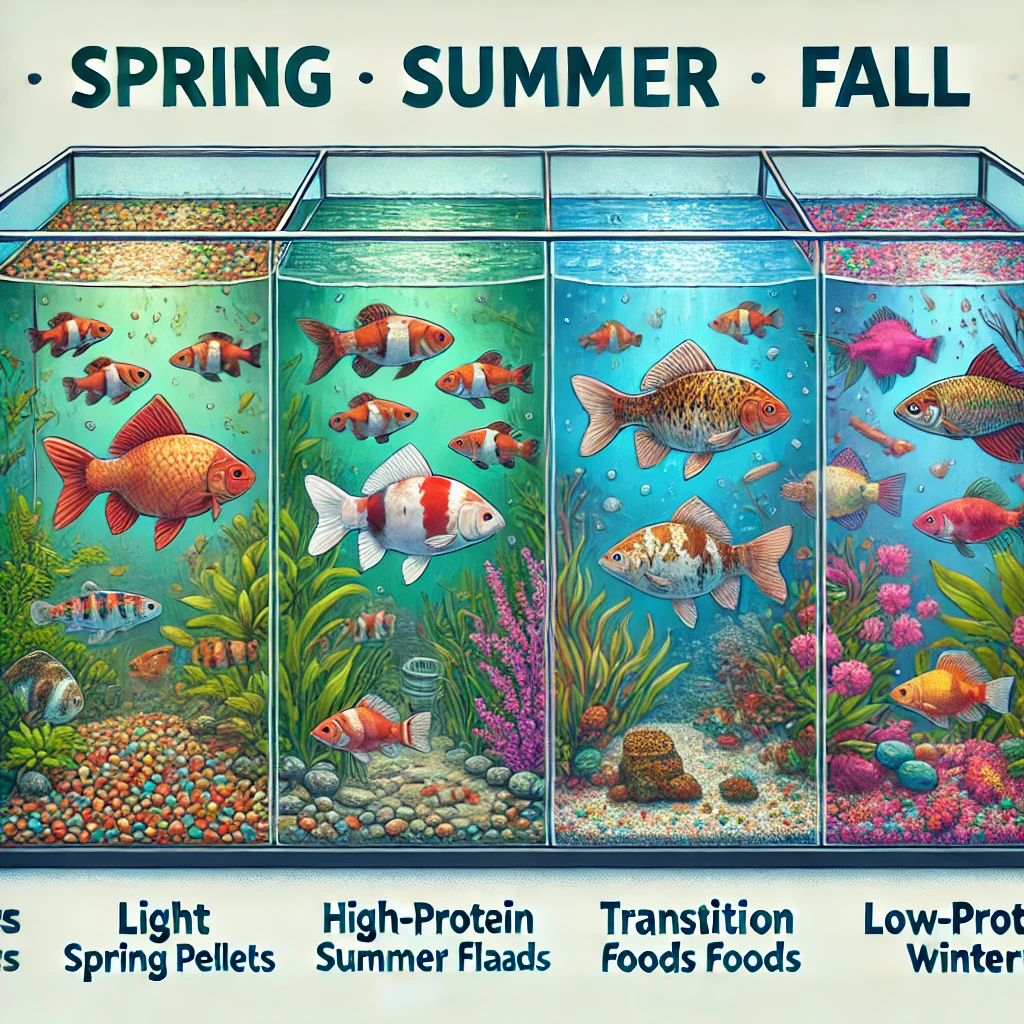How Seasonal Changes Affect Your Fish’s Diet

When it comes to caring for freshwater fish, most hobbyists pay close attention to water temperature, pH levels, and tank cleanliness—but one critical area often overlooked is how seasonal changes can affect your fish’s diet and feeding needs.
Just like animals in the wild, aquarium fish are sensitive to changes in light, temperature, and natural food availability, which fluctuate with the seasons. Whether you’re experiencing a hot summer or a cold winter, your fish’s metabolism, appetite, and nutritional needs shift accordingly. That means it’s essential to adjust their diet to the changing environment to keep them healthy and thriving.
In this guide, we’ll explore the science behind how seasonal variations impact fish health, metabolism, and digestion and how to adapt your feeding practices. From choosing the best freshwater fish food during cooler months to increasing energy-rich options in the summer, we’ll cover it all.
Let’s dive in and ensure your fish are well-nourished—year-round.
How Fish Metabolism Changes With the Seasons
Fish are ectothermic (cold-blooded), meaning their body temperature and metabolism are directly influenced by the temperature of their surroundings. In an outdoor pond or unheated tank, temperature fluctuations can drastically affect their eating patterns and energy needs.
Spring and Fall: Transition Seasons
During spring and fall, temperatures tend to fluctuate daily. These transitions can confuse a fish’s metabolism.
- Appetite may increase or decrease erratically.
- Digestive efficiency is lower in inconsistent temperatures.
- Gradual feeding adjustments are needed.
Summer: Increased Metabolic Rates
Warm temperatures in summer speed up fish metabolism.
- Fish eat more and digest food faster.
- Energy demands are higher due to increased activity.
- Diets should be protein-rich and easily digestible.
Winter: Slower Digestion & Reduced Activity
In colder conditions, especially in outdoor ponds or tanks without heaters:
- Fish become less active and rest at the bottom of the tank or pond.
- Digestion slows down, and feeding should be reduced or stopped entirely.
- Hard-to-digest foods can cause bloating or illness.
✔ Pro Tip: Always monitor water temperature before feeding. Use a reliable thermometer to guide feeding decisions.
Seasonal Feeding Guidelines for Freshwater Fish
Each season comes with unique nutritional requirements. By adjusting your fish’s diet accordingly, you promote better digestion, reduce waste, and boost immunity.
Spring: Start Slow and Light
As temperatures begin to rise, fish become more active—but their digestive system is still adjusting.
- Use easily digestible, wheat germ-based foods.
- Feed in small quantities, 1–2 times daily.
- Look for floating pellets to prevent waste buildup.
This is also the ideal time to start reintroducing high-quality freshwater fish food to help fish regain strength after the winter slowdown.
Summer: High Energy and Protein-Rich Diets
During the peak of summer, fish are at their most active.
- Choose foods with higher protein content (35% or more).
- Offer a mix of pellets, flakes, and frozen/live foods for variety.
- Feed 2–3 times a day in smaller portions to avoid overfeeding.
✔ Additions to consider:
- Brine shrimp and bloodworms for extra protein.
- Spirulina-based flakes to enhance coloration and immune health.
- The best freshwater fish food blends often include essential fatty acids for active fish.
Fall: Transition Back to Low Protein
As the weather begins to cool, metabolism slows down again.
- Reduce feeding frequency to 1–2 times daily.
- Begin switching back to low-protein, easy-to-digest options.
- Wheat germ and plant-based pellets help fish prepare for winter.
✔ Pro Tip: This is a great time to reinforce your fish’s immune system with vitamin-enriched food blends.
Winter: Minimal or No Feeding
If your tank is unheated and water temperatures drop below 50°F (10°C):
- Most freshwater fish stop eating altogether.
- Digestive systems are inactive; uneaten food can rot and pollute the water.
- Only feed if fish are active and responsive.
If your tank is indoors and temperature-controlled, maintain a light feeding schedule using low-protein foods.
✔ Pro Tip: For heated tanks, follow a modified fall feeding pattern—less frequent meals and low-fat options.
Choosing the Right Foods for Seasonal Shifts
Key Ingredients to Look For:
- Wheat Germ: Easy to digest; ideal for cold weather.
- Spirulina: Supports immune health and coloration.
- Insect Meal: A sustainable, high-protein option for growth phases.
- Plant-Based Proteins: Essential for herbivorous and omnivorous species.
Top Food Forms to Consider Year-Round:
- Pellets: Versatile and available in sinking/floating options.
- Flakes: Great for small or top-feeding fish.
- Gel Foods: Easy to digest and customizable.
- Frozen Foods: Excellent in summer for variety and enrichment.
✔ Remember: The best freshwater fish food isn’t just about ingredients—it’s also about digestibility and appropriate feeding for your species.
Feeding Mistakes to Avoid with Changing Seasons
Even experienced fish keepers can make seasonal feeding mistakes. Watch out for the following:
❌ Feeding too much in cold weather
Cold slows digestion—uneaten food can spoil and pollute the tank.
❌ Not adjusting for increased appetite in summer
Fish burn more energy and need more frequent feedings in warm water.
❌ Using the same food year-round
Seasonal needs vary—nutritional balance should match activity levels.
❌ Ignoring water temperature
Feeding without checking water temp can result in poor digestion or illness.
✔ Pro Tip: Keep a feeding log to track seasonal changes and feeding habits.
Supporting Immunity Through Diet in Seasonal Transitions
Changing seasons can stress fish, making them vulnerable to disease. One of the best defenses is a strong immune system, supported by a nutrient-dense diet.
Immune-Boosting Additions:
- Garlic Extract: Natural parasite deterrent and appetite stimulant.
- Beta-Glucans: Found in some premium pellet foods, known to stimulate immune cells.
- Vitamin C & E: Essential antioxidants.
- Probiotics: Support gut health and disease resistance.
Many of the best freshwater fish food brands include these ingredients in seasonal formulations. Look for labeled “seasonal support” or “immune boost” options.
Conclusion: Adapting Your Feeding Routine for Healthier Fish
Your fish’s dietary needs aren’t static—they change with the seasons, just like in the wild. By recognizing and adapting to these shifts, you’re not just providing food—you’re actively enhancing their health, growth, color, and lifespan.
From high-protein summer feeds to digestible winter blends, choosing the right food at the right time ensures your fish stay vibrant, active, and well-nourished all year long. Pair your feeding strategy with water quality maintenance and species-specific care for a thriving aquarium.
For a wide selection of seasonally appropriate, vet-recommended freshwater fish food, browse the curated options at KwikPets.com—where quality meets care for your aquatic companions.
Frequently Asked Questions (FAQs)
1. Do I need to change fish food every season?
Yes, adjusting food seasonally helps match your fish’s metabolism, digestion, and nutritional needs for optimal health.
2. What’s the best food for winter feeding?
Choose low-protein, easily digestible options like wheat germ pellets and avoid high-fat or rich foods.
3. How do I know if I’m feeding too much in cold weather?
If food remains uneaten after 5 minutes or fish are inactive, you’re likely overfeeding. Reduce or pause feeding.
4. Can I feed the same food to tropical and cold-water fish in the same tank?
Not ideally. Different species have different needs, especially in mixed-community tanks. Opt for universal blends or feed separately.
5. Are there all-season fish foods available?
Yes, many reputable brands offer all-season formulas—but it’s still best to adjust feeding quantity and frequency seasonally.








